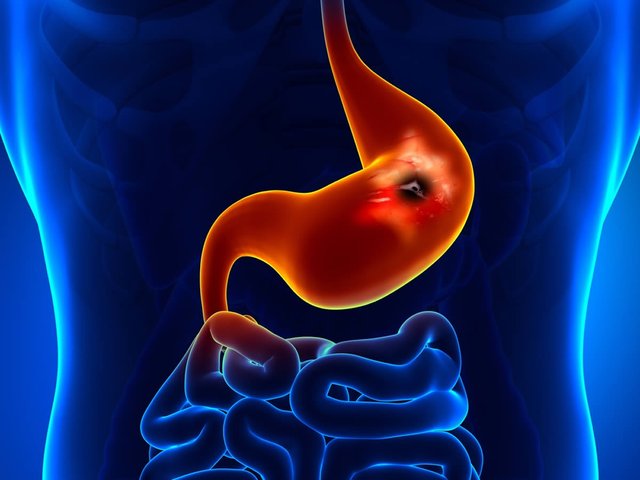Backflow of gastric acid into the oesophagus causes inflammation
A reflux disease is defined as an abnormally increased reflux of acid stomach contents into the esophagus. The reflux usually persists for a long time and is often caused by a disturbed closing mechanism of the lower esophageal muscle. In medicine, the disease is also known as GERD (gastroesophageal reflux disease) or gastroesophageal reflux disease. In medicine and Kurklinik Verzeichnis, it is often simply referred to as reflux.
The aggressive gastric juice, especially the hydrochloric acid contained in the gastric juice, attacks the mucous membrane of the oesophagus and begins to change inflammatory. This leads to inflammation of the esophagus, reflux esophagitis (ERD, erosive reflux disease). Reflux esophagitis causes inflammatory mucous membrane ulcers in the esophagus. Inflammation of the esophagus by reflux can change the mucous membrane over time to such an extent that a Barrett syndrome (mucous membrane transformations) develops.
The reflux is not always an indication for a disease, it can also occur in healthy people, e.g. after a high-fat meal or wine consumption. Only if there is frequent reflux, so that the acid stomach contents have longer contact with the mucous membrane of the oesophagus, can the first significant damage develop.
About ten percent of the population in western industrialized countries suffers from reflux disease. In 60 percent of all people affected, reflux disease occurs without inflammation of the esophagus. These patients only suffer from complaints such as heartburn and acid burping. This form is called non-erosive reflux disease (NERD). Women and men are affected equally, mostly people over the age of 50, infants (in the first six months) and pregnant women.
The actual reflux esophagitis (inflammation of the esophagus), on the other hand, occurs more frequently in men than in women. Barrett’s syndrome, which affects 60 to 70 percent of men, is also more common.
The lower sphincter muscle of the esophagus plays an important role in the development of reflux disease. Normally, the muscle is tense and closes the esophagus to the stomach. When food is taken, it is opened in order to be able to transport the food into the stomach. In reflux disease, the muscle relaxes independently of the food intake and there is always a certain opening. The exact cause of this has not yet been clarified. It can be assumed that a gap in the diaphragm (diaphragmatic hernia) leads to a weakness of the sphincter muscle. The esophagus normally lies above the diaphragm and the stomach below it. Certain parts of the stomach slide into the chest through the fracture. The seal between the esophagus and stomach is impaired. However, it is still unclear whether diaphragmatic hernia really plays an important role in the development of reflux disease, because only a few patients with hiatus hernia actually have reflux disease.
An increased reflux of gastric juice into the esophagus does not always lead to damage to the mucous membrane, which depends on various factors, among others. Normally, the esophagus itself is able to transport the gastric juice that has reached the esophagus downwards after a short contact by its own movements (peristalsis). If the mobility of the esophagus is reduced, the self-cleaning mechanism of the esophagus is no longer as effective.

Symptoms of esophageal inflammation
A typical symptom of reflux disease is heartburn. Heartburn is associated with pain behind the breastbone. After large meals, when bending over and lying down, these complaints are intensified.
Acidic and non-acidic burping of food (regurgitation) occurs relatively frequently, especially at night. Here the acid stomach contents flow into the oesophagus, possibly even into the oral cavity. It is usually triggered after eating, by the consumption of alcohol and smoking, as well as by bending down and lying down. Often it comes to swallowing difficulties.
Other possible symptoms of reflux and esophagitis are pain in the upper abdomen, weight loss, nausea and vomiting, morning hoarseness and chronic cough. About half of all those affected feel like they have a lump in their throat.
These symptoms can be full, mild or absent. If complaints are present, they often increase when lying down, because gravity is additionally omitted as a “reflux brake”. On the basis of the complaints, no conclusion can be drawn about the severity of the reflux disease. There are cases in which severe symptoms are present, but the mucous membrane findings are nevertheless inconspicuous.
Since reflux disease is chronic, it can promote the development of other diseases or lead to complications. If reflux disease persists for a long time, gastric acid corrodes the mucous membrane of the oesophagus. The result is inflammation (reflux esophagitis), injuries to the mucous membrane of the oesophagus and even bleeding and ulcers. Strictures (severe constrictions) caused by scars can sometimes occur. Over time, there is a structural change in the mucous membrane in the esophagus, which can lead to a so-called Barrett syndrome, which is considered a precursor to esophageal cancer.
The reflux also causes diseases of the respiratory tract and the paranasal sinuses. Possible are chronic laryngitis (inflammation of the larynx), chronic bronchitis, chronic obstructive pulmonary disease (COPD), chronic sinusitis (inflammation of the paranasal sinuses) or chronic otitis (inflammation of the ear).








